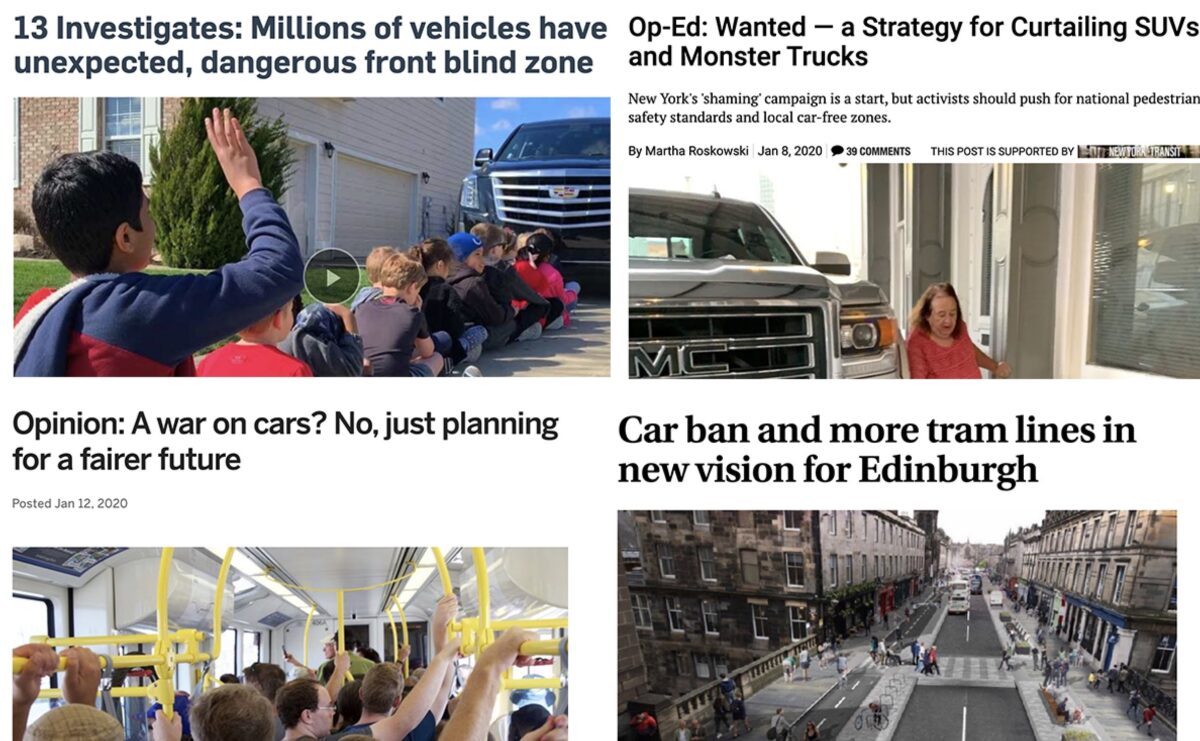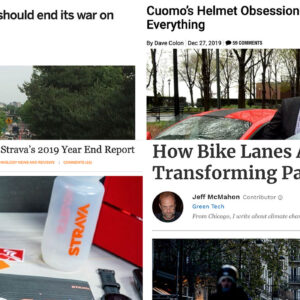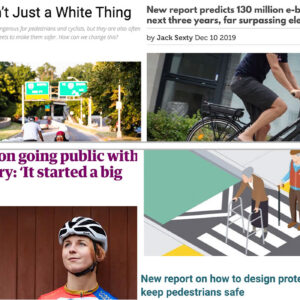This week’s Monday Roundup is brought to you by River City Bicycles (706 SE Martin Luther King Jr. Blvd), serving your everyday cycling needs for 23 years.
Here are the most noteworthy items we came across in the past seven days…
Car control now!: Trucks and SUVs have gotten absurdly large and deadly. Martha Roskowski lays out the problem and offers steps to solve it.
“Blind zones” kill: And this is one of the first mainstream media pieces I’ve seen that exposes those aforementioned dangers with excellent and irrefutable graphics.
All politics is local: The Trump Administration wants to weaken NEPA, the federal law that regulates the environmental impact of large transportation infrastructure projects, because they believe environmental impact statements create too much red tape.
Advertisement
Clarion call from Chicago: Courtney Cobbs says the Windy City’s mayor needs to stop “coddling drivers” and build a network of protected bike lanes. Someone should copy/paste her essay and submit it to The Oregonian.
Whose streets?: The new OurStreets app (from makers of a Twitter bot that tracked drivers’ citations based on license plate numbers) will use crowdsourced data on dangerous and disrespectful drivers to target solutions and trouble spots.
Bike thief rage: A California couple let their anger at bike thieves get the best of them by setting up bait bikes and beating would-be thieves with bats.
Stop freaking out: Lots of folks I know found a bit of solace from their climate change anxiety by reading this piece in the NY Times about how to stop stressing and start acting.
Advertisement
Economic impact: $390 million in health savings, 81,000 jobs, and $8.2 billion to Washington’s economy every year: That’s the economic impact that bike trails and paths have in Washington state according to a new report.
Too many drivers: It’s simple. If leaders want to reduce greenhouse gas emissions, they must push projects and policies the reduce car use.
Be like Edinburgh: This city in Scotland wants to be carbon neutral by 2030 and making parts of its downtown carfree and boosting investment in biking and transit are pillars of its plan to do so.
Fairer future: Sara Wright from Oregon Environmental Council responded to that misguided “war on cars” editorial in The Oregonian by saying our problem is too much money being thrown at the status quo, not our investments in active transportation and transit.
— Jonathan Maus: (503) 706-8804, @jonathan_maus on Twitter and jonathan@bikeportland.org
— Get our headlines delivered to your inbox.
— Support this independent community media outlet with a one-time contribution or monthly subscription.







Thanks for reading.
BikePortland has served this community with independent community journalism since 2005. We rely on subscriptions from readers like you to survive. Your financial support is vital in keeping this valuable resource alive and well.
Please subscribe today to strengthen and expand our work.
“get the best of them ”
This reads like bike portland is attempting to provide an excuse for what appears to be assault with a deadly weapon. It should be noted that this blog promoted calls for the murder of bike thieves as part of a conference. If bike portland is going to be quick to take injury at calls for violence against people biking, perhaps it could make some sort of minimal attempt to not appear hypocritical when doing so.
Hi soren. I’m not sure what exactly your beef is with me on this. I’ve been careful to not promote the “death to bike thieves” stuff on here and I think it’s pretty low of you to insinuate otherwise in your comment. I don’t condone violence against anyone. Period. Thanks for the comment.
1. The agenda for the “bike theft” summpy that you organized and promoted here included a panel discussion prefaced by a “death to bike thieves” quote:
https://bikeportland.org/wp-content/uploads/2014/12/BikeTheftSummitAgenda4.pdf
2. You highlighted Hart Knocker’s call to kill motorists, which you later removed:
https://bikeportland.org/2015/01/27/thoughts-hart-noecker-community-131331
From this…
“Death to bike thieves!” is a popular mantra; but catching thieves in the act, giving them due
process, and then holding them accountable, requires a bit more tact than vigilante justice.
You got to this?
“It should be noted that this blog promoted calls for the murder of bike thieves as part of a conference.”
It seems like you are really going out of your way to unfairly denigrate this blog.
Personally, I think there should be an assumed risk of a physical beating if one is trying to steal the property of another. Simply one more thing to consider when making the decision to victimize someone else.
And if you are beating someone with a baseball bat, you should assume you could be prosecuted for assault with a deadly weapon, as happened in this case:
“Visalia police arrested the couple Wednesday. They face charges of assault with a deadly weapon and conspiracy.”
Could be. I still think there should be an implied risk of a very negative outcome.
What these guys did went a little too far – it was essentially a sting operation done by non-law enforcement individuals. And the baseball bats were a little much – something like a wiffleball bat might have been a better choice.
Should we also lock up individuals who bait bike thieves into taking a long ride on a stolen bike attached to a short rope?
https://www.youtube.com/watch?v=VyBjAMXqFGw
Harmless fun at the expense of those who deserve it the most.
In America, it seems like the biggest risk of beating up someone anywhere would be them shooting you with a gun.
Yeah, well that’s just like, your opinion, man.
My opinion is that it does not sound at all like Bikeportland is attempting to offer an excuse for violence. Further, my opinion is that you must have some weird issue to say “this blog promoted calls for the murder of bike thieves” because, without factual support, that sounds like slander to me. Care to provide some evidence of your claim?
I think it is a cheap shot to accuse B.P. of being soft on talk of violence directed towards thieves and dangerous drivers. No other blog on the internet in my experience is more diligent about curbing the tendencies of contributors or commenters to direct strongly worded invective towards those who inhabit the dark end of the transportation universe.
+1 of what everyone else has said to help the ratio
I appreciated reading this article and it is absurd to suggest that the bikeportland blog promotes violence. I do think that that article should be a wake up call for Portland: the continues lack of enforcement could easily entice vigilante justice here. Continually being threatened by drivers, property theft, having parks taken over and trashed are all very frustrating on a personal level, but are not prioritized by police.
I disagree with your reading of the phrase “get the best of them.” I think that clearly means that Bike Portland condemns the actions of the couple who beat would-be bike thieves.
Accusing Jonathan of this? He strikes me as one of the fairest people out there and seems to tolerate a great many of our opinions whether he agrees with them or not. Soren you have reached a brand new low.
A few of us have been using the Safelanes.org app to compile violations. Downside is they only report to enforcement in SF.
Have you (the app users in Portland) tried or considered using the information for a citizen initiated citation?
You are currently required to ID the driver, so you can’t write a parking ticket unless you catch them while they’re actively parking. I’m hoping that changes, and that eventually citizen tickets are issued to the owner of the vehicle.
This looks a lot easier than reporting to Bike Lane Uprising, and is not bicycle specific so appeals to a larger base. Installed!
Uninstalled! The “app” from the Play Store is really just a web shortcut. So I uninstalled the app and tried to make my own shortcut and it keeps installing the real app (that’s not a web shortcut?) without permission.
If you aren’t aware that there’s a blind zone in front of your car, you are absolutely not competent to be driving a car. It’s terrifying just how many dangerously incompetent drivers are out on the roads we’re cycling and walking on.
The front blind spot thing is why I think station wagons and minivans should make a comeback in a big way. The front blind spot on a sedan-like wagon is so much less dangerous and the cargo capacity is pretty much the same (or better than) most “compact” CUVs. Most of the popular CUVs are basically jacked up hatchbacks and wagons playing pretend anyway.
The reason everyone wants CUVs is because there is essentially an arms race among drivers to be the one who gets to see over and above all the other traffic and it provides an air of safety. They are easier to get in and out of and harder to get blinded by pickup truck and SUV headlights as well.
I have seen several studies that show pedestrian danger increases a lot if the front edge of the hood is above 30″; I think this as well as the front blind spot test should be considered in the safety rating system such that high up trucks and CUVs are essentially barred from the highest safety ratings that everyone looks at.
I borrow a late-90s F150 occasionally for house project. I had it parked next to a 2020 F150 yesterday, and the height difference at the front of the hood was probably 10″ or so. Basically the same truck otherwise. It’s crazy.
I thought Sara Wright did a terrific job of rebutting the “war on cars” piece in the O. She used the word “bike” exactly once in her essay, which is very smart b/c it takes the focus off of the “us vs them” angle that the O’s “war on cars” piece took.
The O should do a better job of tamping down the “us vs them” trope, but they seem no better than Fox nowadays. I wish we had a better local paper.
The Oregonian is part of Advance publications a large private company owned by the Newhouse family of NY. We actually DO have a better local paper, The Portland Tribune owned by Oregonian Robert B. Pamplin Jr.
I am not convinced that anybody, including farmers and contractors, need these monster “light” trucks. I grew up in Australia, and also lived in New Zealand for a year. Neither of these countries have large inventories of these large vehicles (and I can assure you that many Australians and New Zealanders would love to have them). The standard farm/contractor vehicle in those countries is the ute, known in the USA as a coupe utility. Essentially it is a version of the standard GM/Ford/Chrysler sedan built with a truck bed. When I was younger, utes were a little smaller than the current Ford Ranger. Ford/GM/Chrysler also built “panel vans” which were like two door station wagons with no back seats or side rear windows. For example, the typical Ford Falcon was available in four body styles: sedan, stationwagon, utility (coupe utility) and van – each with the same front profile.
When I look around my neighbors, work colleagues and acquaintances, very few of us have a need to own large SUVs/trucks (full disclosure, I drive a Mazda CX-9 SUV), rarely, if ever are we toting enough people or stuff to justify these vehicles. If they weren’t available at low/moderate cost, we wouldn’t buy them. If there were a Mazda 6 stationwagon, I would likely be driving that rather than the CX-9.
Matthew: I agree…as a child who spent summers on the family farm [and now have an office that shares a parking lot with too many off the shelf monster trucks at an auto showroom]…these new trucks have grown too big for useful daily farm use…it must be a pain to lift items into the rear bed / cargo area…plus jumping up or down if more fatiguing / dangerous (even for farm dogs too).
And as for Aussie UTEs…we had a few US ones too: Ford Falcon/ Ranchero (early 60s) and the El Camino (60s-70s).
About the fatigue factor of lifting loads into those ever-taller codpieces (that no one ever lifts a load into): I just saw a commercial that featured a special tailgate that came down lower to help the little darlings put their one bag of groceries in.
It’s pathetic what has happened in the motor vehicle realm here in the US. I’m now expecting one of these to come with an elevator or a seat that automatically lowers out as standard equipment.
Ms Marris is off the mark with her NYTimes essay. She has taken Mary Annaise Heglar’s “All of the Above” formulation and turned it into a call for only systems changes. This is nothing more than a delaying tactic. We won’t get systems change until we get politically significant numbers of people lowering their personal emissions so that a majority has seen the potential by either doing (some) of what can be done or knowing someone who has.
I actually had a bit of back-and-forth with Ms Heglar when she first published her essay on this. She was adamant that she is calling for both personal and systems changes. I told her I feared it would be misread and be used to justify delays and I’m disappointed to see that I was probably correct.
That said, yes we need to find that sweet spot that lets us show what can be done without any virtue signaling or holier than thou. Part of that will involve making people do some soul searching and feel guilty. That’s a feature of making change happen, not a bug.
Oops, didn’t mean to nest this here. I forgot to reload the page after replying to Todd.
Two more screw ups and I can retire for the day. 🙂
Per Car Control article and …NHTSAs New Car Assessment Program (NCAP):
https://www.nhtsa.gov/press-releases/ncap-upgrades-coming
PR: NHTSA Announces Coming Upgrades to New Car Assessment Program
NHTSA plans to propose major upgrades to NCAP in 2020 [and] will also consider new technologies tied to the safety of pedestrians and other vulnerable road users such as cyclists.
NHTSA is working to publish a Federal Register Notice in 2020 that will seek comment on upgrades to NCAP. [TB: No update on-line as to when this will happen.]
Bike thief rage: So how exactly ARE we allowed to subdue thieves? I think a bat sounds like they got off easy.
The city I live in, I hear periodically of bicycles stolen.
The bike was unlocked…
It was on the front porch or in the yard…
For days…
In a neighborhood that strangers often pass through…
I have yet to hear of anyone having their bike stolen if it was locked, even with a cheap $5 cable lock.
(Obviously I no longer live in Portland, home of the Kryptonite Portland lock with a 15/10 rating and insane thieves who casually and brazenly carry angle grinders and giant bolt cutters with them.)
Let’s put this in perspective. Leaving moral or ethical judgements out of it: typical replacement value for a commuter bike is about $2000. One swing of a baseball bat could put someone in the emergency room, where it costs $2000 just to get in the door. The total cost to society is potentially huge, and some injuries never heal in a satisfactory way.
Inflicting personal injury is not a good way to sort this out. I like my bikes and don’t want to lose them but I hope to never lose touch with my humanity to such a degree that I would injure another person over a material thing that can be replaced.
Maybe I have too many bikes?
Interesting.
I lived in OZ many decades ago and tried to scope the car culture there. Also a brief visit to New Zed Land.
Most rural work was then done with trailers on ordinary cars. Australia is a continent the size of the lower 48 states with the population of southern California: a small market with limited capabilities of production. NZ is even smaller.
GM Australia built “Holden” cars there: unique vehicles with cheap components made possible by GM’s enormous purchasing power. The rare (large and powerful) American car was extremely costly due to tariffs and conversion to right-hand drive. NZ, with no national automotive industry, once required purchasers to have full “overseas” funds to buy a new vehicle, which led to amazing ingenuity in keeping (really) old things running.
“Panel vans” long ago were built in the US too, being called “sedan deliveries.”
Congratulations on driving Mazda. A small but excellent company.
People are really shocked when they buy a giant SUV whose main design feature is a gigantic nose and front grille that you can’t see over?
Mentioned this again not too long ago, but certain vehicles are allowed to be depreciated by a businesses for a tax credit (I believe it’s up to $45K IIRC – used to be called the ‘Hummer loophole’). My friend traded his Suby for a Chevy Silverado and more recently a Ram diesel to take advantage of this (and he actually gets better gas mileage in the diesel than his old turbo Suby did). My own company has a massive fleet of Ford and Ram 4wd trucks used to service wind farms, and I’m sure they chose the tax-advantaged models but they are appropriate for the work they’re actually used for. Much different than what we see similar-sized rigs on downtown streets used for, to be sure!